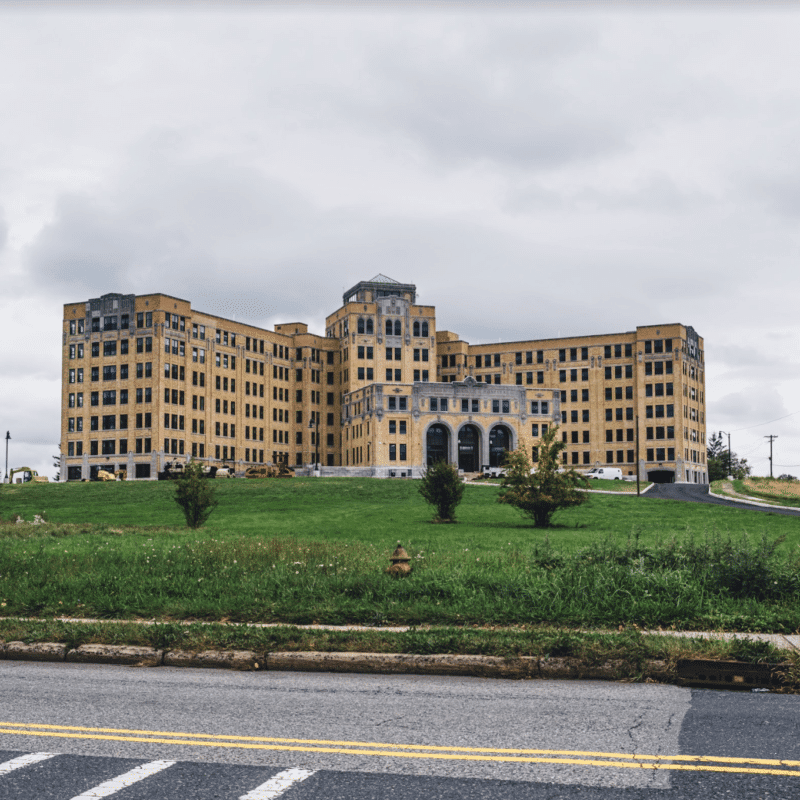We’re sharing some stories of the historical hospitals and asylums that used to be prevalent in North Jersey. At the turn of the 20th Century, most of New Jersey was farmland and open countryside. Populations grew in the nearby cities, like New York and Newark, and these facilities were built in the relatively open, rural areas of North Jersey. That is why the region has become a hub for many of these hospitals abandoned in the past. Read on for the fascinating stories of North Jersey’s forgotten hospitals.
The stories of these buildings give us greater compassion and understanding of those dealing with or suffering from illnesses in the early 20th century. The loss of these hospitals reveals a shift toward modern medicine and family-oriented solutions, the buildings represent a golden time in institutional architecture when the design of highly functioning, well-used facilities was meant to be forces for social good. It is heartbreaking that many of the buildings did not survive abandonment, and most were too far gone to be saved.
Trenton Psychiatric Hospital | Trenton
Trenton Psychiatric Hospital was the first public mental hospital in the state of New Jersey. At the time of its founding, on May 15, 1848, it was referred to as the New Jersey State Lunatic Asylum by Dorothea Dix, a nurse, and mental health activist. She was responsible for building the facility, among other first-generation mental asylums in the United States. In 1881 she eventually retired at a residence constructed just for her on the hospital grounds.
The demand for care remained relatively low until the early 20th century when overcrowding became a grave concern. In 1907, Dr. Henry Cotton became the medical director and believed that non-symptomatic infections were the cause of mental illness. His standard procedure was to remove teeth and other body parts from the hospital’s patients, which caused hundreds of fatalities and thousands of disfigured patients.
John Nash, the Princeton professor, brilliant mathematician, and Nobel Prize winner, was housed in the Trenton Psychiatric Hospital to treat his schizophrenia. His story was memorialized in the movie “A Beautiful Mind” starring Russell Crowe. Dr. Nash is known for his economics research and development and application of game theory to economic behaviors.
New Jersey Sanitorium for Tuberculosis Diseases | Glen Gardner
In 1907, New Jersey opened its only state-owned sanatorium to care for the 500 expected annual cases of tuberculosis that occurred each year. Initially, the cottage-style facility was to be used for the educational purposes of sharing novel methods for treating tuberculosis and caring for patients that were highly functioning or considered “curables.” The sanatorium expanded its mission to serve a broader range of patients looking for long-term care. Between the years 1907 and 1929, it is estimated that more than 10,000 patients were treated. In the 1950s, with the improved treatment techniques against tuberculosis, the sanatorium changed its focus to cover all chest diseases. The building found different purposes in later years as a nursing home and eventually a 288-bed psychiatric hospital. In 2011, all remaining facilities were closed, and the abandoned hospital complex still sits vacant and rotting to this day.
Read More: The History of the Jersey Devil
Greystone Park Psychiatric Hospital AKA State Asylum for the Insane | Morris Plains
View this post on Instagram
Morris Plains doesn’t conjure up images that would suggest a fitting location for a psychiatric hospital, but in 1876, a new facility was necessary, and the rolling farmlands fit the bill. With the successful funding of the Trenton Psychiatric Hospital, Dorothea Dix lobbied for the construction of more facilities. Unfortunately, there was just the Trenton Asylum at the time, and it was subject to excessive overcrowding with sub-standard accommodations. Greystone, a 673,700 square foot complex, was built to relieve this severely crowded “lunatic asylum” in Trenton. Dorothea Dix convinced the legislature to approve $2.5 million for the 743 acres necessary to build.
After extensive research to find a suitable location, the site for the new hospital was chosen, consisting of several farms and vacant lots. Samuel Sloan designed Greystone to accommodate 600 patients in 40 wards, split into two wings separated by gender. Sloan based the design on the ideals of a fellow designer named Thomas Story Kirkbride, whose work and theories influenced many of the hospital buildings at the time. The care and comfort of the patients were taken very seriously. Every ward was designed to lodge 20 patients to showcase views of the surrounding grounds while also providing specific spaces for dining, exercise, and activities. The furnishings were also top-notch, such as wool rugs, pianos, and beautiful flowers cultivated from the garden.
Part of the regimen to improve patients’ health at Greystone was the farm experience. Patients grew food and performed strenuous tasks laboring about the farmland, and it was believed to be a benefit to their mental health. They suspected that this system didn’t only benefit the patients but also the pockets of those who ran the hospital.
By 1895, Greystone too suffered from overcrowding. This became a serious health concern for spreading infectious diseases, but unfortunately, the situation did not improve. Each year more patients were crammed into the institution on cots placed in hallways, dining halls, and activity rooms. As a result, the once majestic and restful hospital had become overrun with those in need of help.
Electroconvulsive therapy, along with hydrotherapy, was soon introduced, two highly controversial forms of rehabilitation. By 1911 the “State Asylum at Morris Plains” was its own small town with nearly 3,000 patients. It even had a dental clinic, tuberculosis pavilion, fire department, greenhouse, and piggery. In 1924 the hospital was given its current name, Greystone Park Psychiatric Center.
As the 1970s and 1980s brought strong sentiments for deinstitutionalization, it was believed that long-suffering mental health patients were better off with their families rather than treated in overcrowded facilities. The discovery of new mental health drugs also made it possible for patients to improve and rejoin society. The hospital still had patients into the 1990s, but the conditions were known to be dire. Patients often escaped and committed serious crimes, while there were also unchecked abuses by staff members towards the hospital’s female patients. As a result, many parts of the building became derelict and were subsequently destroyed.
In the 21st century, much effort was made to repair the hospital buildings and clean the property of asbestos and dangerous chemicals. As a result, a new psychiatric hospital was built on the campus. The original, magnificent Victorian building was demolished but some of the architectural details and motifs were rescued in the end.
Essex County Isolation Hospital | Belleville

Take a ride southeast down Belleville Avenue, and you’ll soon find yourself in the presence of an incredible, old hospital once called the Essex County Isolation Hospital. The lawn stretches up a dramatic hill, highlighting both the stark nature of the architecture and the surprising size of the building. It looks like the setting of a movie, and it was used as a filming location for Ron Howard’s “A Beautiful Mind,” starring Russell Crowe as John Nash (mentioned above).
In 1896, the City of Newark purchased this site in order to expand its public health facilities. As the system already had two other hospitals (The New Jersey Sanitorium for Tuberculosis Diseases in Glen Gardner and The Essex County Hospital in Cedar Grove for Psychiatrics), the City was interested in building a nearby hospital that would serve as an isolation unit for infectious diseases. Doctors lacked treatments for diseases like tuberculosis, polio, and typhoid, which like Covid today, spread throughout communities through coughing and shared germs. The only way to care for these patients was to isolate them from others to hinder the spread of the infections.
The original hospital complex was established in 1908 and was more straightforward and cheaper than the current building. In 1932, the Art Deco building known today was built. It was often referred to as “The Soho” due to its location in the Soho section of Belleville. The building’s lawn was a conscious choice due to the nature of infectious diseases. Fresh air was one of the sole treatments for debilitating and deadly infectious diseases and often the only treatment available to improve the condition. The Soho had a solarium ward available to patients for easy access to fresh air and sunlight and then iron lungs to help ease breathing by reducing the pressure on the lungs.
Over time, the treatment and prevention for tuberculosis were better understood, the cases of contagious illness declined, and the hospital began to take on elderly patients in empty wings. In addition, it was reported that during the Cold War, the building was designated a bomb shelter in case of a nuclear attack.
As the 1950s rolled around, locals and county officials suggested that the hospital be closed. It remained occupied in various capacities, albeit in a state of extreme disrepair. Despite being the Garden State Cancer Center headquarters in 1996, much of the unused building was abandoned. Finally, in 2011, the Cancer Center was shut down, and the property was foreclosed upon.
There were always rumors about this spooky asylum on a hill, hidden underground tunnels, ghosts, and other ominous spirits. Today the building suffers from vandalism and fires, but there are still signs of construction, and it’s said to be the future site of a 240+ unit apartment complex. We’ll just have to wait and see when the tenants move in, whether it’s a little haunted or not.
The Overbrook Asylum AKA Essex County Hospital | Cedar Grove
View this post on Instagram
The Overbrook Asylum, also known as the Essex County Hospital, is a famous site known across the country for its numerous facilities, rumors of hauntings, and the stories from those who experienced it.
In 1896, as the Newark Hospital was burdened with too many patients, the City of Newark bought 325 acres of land in Cedar Grove to build a new hospital. The location was closed for its remote, higher altitude, which people believed would provide pleasant views for rehabilitation. It was known as Overbrook for its proximity to the Peckman River. The city built various buildings through the years, such as dormitories for patients, a powerhouse, a laundromat, a theater for live performances, and several acres of farmable land. The idea was that the hospital is entirely self-sufficient. Morgan’s Farm in Cedar Grove supplied dairy and fresh produce to the facility and is today the steward of the facility’s remaining paperwork.
In December of 1917, the hospital suffered the consequences of their self-sufficiency. That winter, the heating boilers failed during freezing weather and resulted in 24 patients freezing in their beds. As with many of the facilities in the region, Overbrook suffered from overcrowding and housed thousands of patients in the 1940s and 50s. Through the years, many of the buildings fell into disrepair and became ripe for troublesome teens and curious locals. While it was technically still a working facility, trespassing was common due to many decaying buildings. In 2007, the hospital eventually opened a new location down the road and sold the property to developers.
See More: Jersey City’s Oldest Building is Actually From Westfield
In its last years before demolition, the Overbrook Asylum had become a place of urban legend frequented by ghost-hunting television crews alike. The state of the building’s decay made it incredibly dangerous, and the labyrinthine interior was easy to get lost inside. Even though the property decreased significantly in size throughout the years, the 90 acres set into the woodlands of Cedar Grove and Verona could be overwhelming. Many of the urban explorers found buildings connected through tunnels, photographing tiny forests growing within the ruins. The stale air was expected, as was the site of mold and humid conditions. The property was thoroughly explored by high school trespassers and ghost hunters alike. The entire complex was demolished in 2018. In its stead are new homes and condominiums.
North Jersey has undoubtedly had an incredible history, and the evolution of its hospitals and asylums are just one part. The tales of these places are fraught with sadness and incomprehensible suffering, we appreciate the early American architecture and the stand-up mission to care for those in need.












